This month’s newsletter from the Pension Integrity Project at Reason Foundation highlights articles, research, opinion, and other information related to public pension challenges and reform efforts across the nation. You can find previous editions here.
In This Issue:
Articles, Research & Spotlights
- Montana’s plan to improve pension funding and governance
- Efforts to undo Alaska’s pension reforms could cost close to $1 billion
- North Dakota’s potential pension reform
- State pension plans’ poor investment results in 2022
- Reason’s PRO Plan offers a modern approach to public retirement
News in Brief
Quotable Quotes on Pension Reform
Data Highlight
Contact the Pension Reform Help Desk
Articles, Research & Spotlights
Two Bills in Montana Could Improve Pension Plan Design and Funding
Montana’s Public Employee Retirement System has $2.2 billion in unfunded liabilities, and if left unaddressed, funding issues are likely to continue. A new reform proposed in the state’s legislature would address some of Montana’s ongoing pension challenges, first by committing employers to make adequate annual contributions and second by setting the existing defined contribution retirement plan as the default benefit for new employees. In recent comments to the House Committee on State Administration, Reason Foundation’s Steven Gassenberger explained how House Bill 226 would reduce long-term costs by locking the state into eliminating its pension debt and reshaping its retirement offerings to fit the modern workforce better. Gassenberger also testified on House Bill 228, which would improve governance by setting stronger boundaries on what pension plan administrators can consider when making investment decisions.
Alaska Pension Bills Could Undo Previous Reform and Cost $800 Million
Following an effort to reopen a pension plan for public workers during last year’s legislative session, Alaska policymakers are again deliberating on several bills that could undo the state’s decision to close its defined benefit pension plans in 2006. Two identical proposals—House Bill 22 and Senate Bill 35—would allow public safety workers to retroactively switch from the existing defined contribution plan to a newly opened defined benefit plan. A Pension Integrity Project evaluation of these bills and an actuarial analysis of potential long-term costs find that this change would add more expensive debt to the plan’s already $5 billion in existing unfunded liabilities and could cost the state an additional $800 million over the next 30 years. Since public safety employees only make up around 10% of the system’s members, this proposal would be a costly move that would benefit a relatively small group.
Updates to North Dakota’s Pension Reform Effort
North Dakota lawmakers continue to discuss House Bill 1040, which would commit participating employers to make required annual payments in full and make the state’s defined contribution plan the only option for new hires. This backgrounder from the Pension Integrity Project responds to a recent statement from the North Dakota Public Employees Retirement System (NDPERS) that claims the adoption of proposed House Bill 1040 would require a drastic reduction to the plan’s discount rate. The system’s claim is inconsistent with other state plans that have undergone similar reforms, and there is no legal or financial requirement to change discounting like this when a pension plan is closed.
Updated 2022 Fiscal Year Investment Results for State Pension Plans
Investment returns are a crucial part of a pension plan’s funding of promised retirement benefits. While the ultimate success and cost of a public pension do not hinge on a single year of market results, each year that a pension plan falls below investment expectations adds to the growing—over $1 trillion nationally by the latest estimates—unfunded liabilities of state-run pension plans. An update to our October 2022 analysis compiles the investment returns reported by state pensions from the 2022 fiscal year. As expected, the research shows 2022 was a notably poor year of investment returns. All state-run pensions saw results that fell short of expectations, leading to significant growth in unfunded liabilities. Reason Foundation finds the median investment return achieved by the listed pension plans was -5.2% in 2022, well below the national average expected rate of return of 7.0%. Following an exceptional 2021, the latest investment results demonstrate that public pensions still have a steep hill to climb to get back to full funding.
PRO Plan: A Better Public Sector Retirement Plan for the Modern Workforce
Beyond the crippling growth of expensive unfunded liabilities, public defined benefit (DB) plans have failed to adjust to the evolving needs of today’s increasingly mobile workforce. Defined contribution (DC) plans aren’t without their shortcomings either, a common concern being that retirees can outlive their retirement savings. Both types of plans suffer from a lack of flexibility and personalization. The Pension Integrity Project’s Personalized Retirement Optimization Plan (PRO Plan) addresses these issues by structuring a guaranteed lifetime income on the foundation of an enhanced DC plan. In this commentary, the developers of the PRO Plan, Richard Hiller and Rod Crane, summarize the advantages of this approach to retirement for public employees.
News in Brief
Paper Proposes a Novel Discounting Method for Public Pensions
Discounting is how pensions calculate the future value of liabilities they have promised, and the rate used for this calculation has a massive impact on their funding. A new paper by Florida International University researchers identifies the problems with current discounting norms, namely their tendency to understate required contributions. They also acknowledge that discounting at a zero-risk rate—a method promoted by some to reflect the guaranteed nature of government pensions—likely overstates funding shortfalls and is too disconnected from financial reality. To strike a more appropriate balance between these two approaches, the researchers propose a new discounting method that applies a lower limit based on the lowest expected return among risky assets. A historical back-testing using this new discounting method going back to 2001 saw most plans (94%) exceeding these investment return expectations, resulting in funding improvements. The full paper is available here.
Quotable Quotes on Pension Reform
“Divestment of these holdings would do nothing to stop climate change. The companies in question can easily replace CalPERS with new investors.”
—Marcie Frost, CEO of the California Public Employees’ Retirement System, on proposed legislation to force divestment from fossil fuel companies, in “Keep Politics Out of CalPERS, Reject Senate Bill 252,” Whittier Daily News, Feb. 8, 2023.
“Each year I’ve been in office, we have reduced the assumed rate of return…If we had the more rosy assumptions, we’d probably be 86, 87% funded…So the fact that we’ve had all this turmoil, had some market turmoil, and we’re basically where we were and probably much better if you had that, I think that’s a good sign. I think we’re going to be able to build from here…At the end of the day, we really want honest accounting. And we can fudge the numbers a little bit, but you know, so we’ve been reducing that assumed rate of return. I think that’s the conservative approach. I think that’s something that makes the most sense.”
—Florida Gov. Ron DeSantis, in “Gov. DeSantis Pushes for More Pension Spending in New Budget,” Florida Politics, Feb. 1, 2023.
Data Highlight
Each month we feature a pension-related chart or infographic of interest generated by our team of Pension Integrity Project analysts. This month, analysts Jordan Campbell and Steve Vu show the distribution of investment returns for state pension plans in 2022. You can access the graph and find more information here.
Contact the Pension Reform Help Desk
Reason Foundation’s Pension Reform Help Desk provides technical assistance for those wishing to pursue pension reform in their states, counties, and cities. Feel free to contact the Reason Pension Reform Help Desk by e-mail at pensionhelpdesk@reason.org.
Follow the discussion on pensions and other governmental reforms at Reason Foundation’s website and on Twitter @ReasonPensions. As we continually strive to improve the publication, please send your questions, comments, and suggestions to zachary.christensen@reason.org.
Stay in Touch with Our Pension Experts
Reason Foundation’s Pension Integrity Project has helped policymakers in states like Arizona, Colorado, Michigan, and Montana implement substantive pension reforms. Our monthly newsletter highlights the latest actuarial analysis and policy insights from our team.

